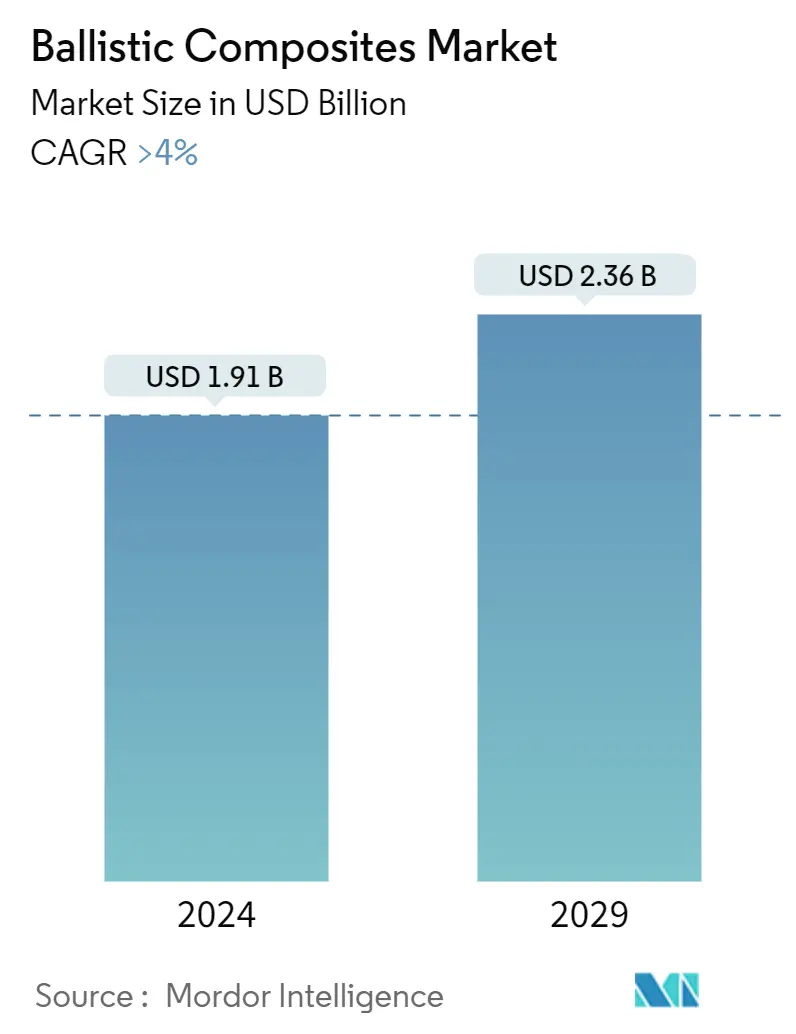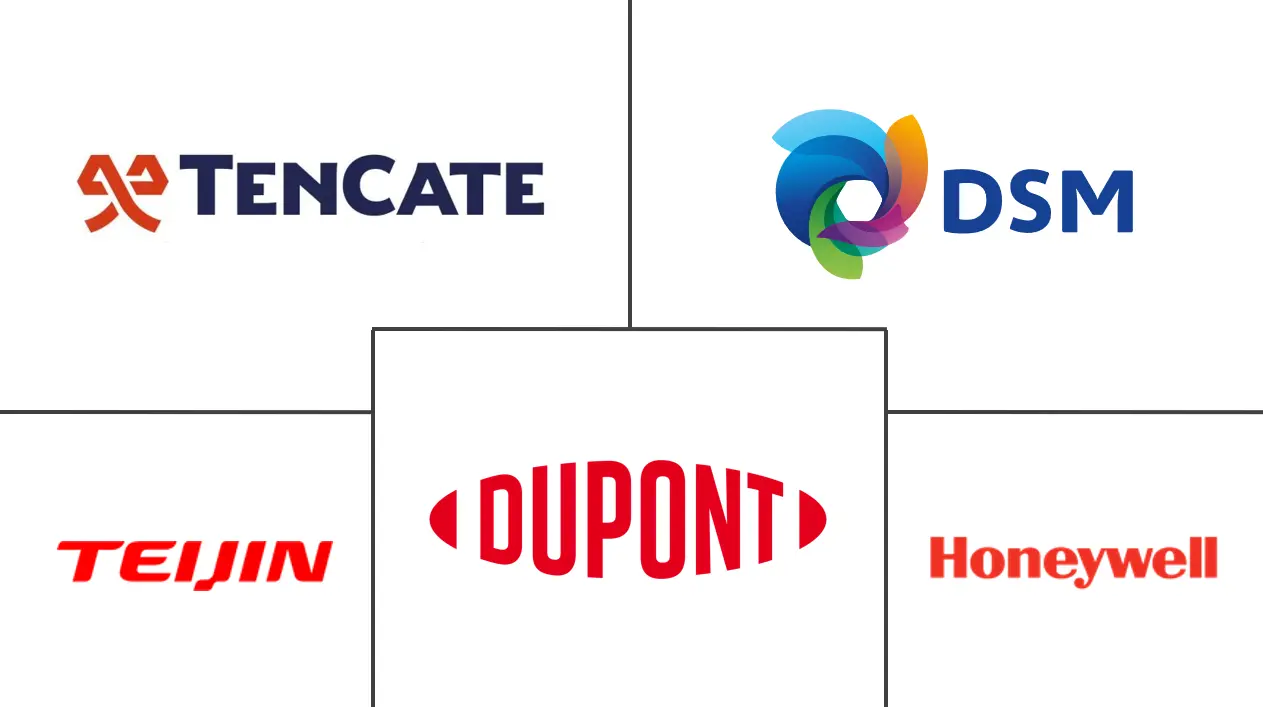Market Size of Ballistic Composites Industry

| Study Period | 2019-2029 |
| Market Size (2024) | USD 1.91 Billion |
| Market Size (2029) | USD 2.36 Billion |
| CAGR (2024 - 2029) | > 4.00 % |
| Fastest Growing Market | North America |
| Largest Market | North America |
| Market Concentration | High |
Major Players
*Disclaimer: Major Players sorted in no particular order |
Ballistic Composites Market Analysis
The Ballistic Composites Market size is estimated at USD 1.91 billion in 2024, and is expected to reach USD 2.36 billion by 2029, growing at a CAGR of greater than 4% during the forecast period (2024-2029).
The COVID-19 pandemic was a mixed bag for the Ballistic Composites Market. While it presented challenges due to supply chain disruptions, demand fluctuations, and economic uncertainty, it also spurred innovation, highlighted new opportunities in security and sustainability, and potentially accelerated the adoption of beneficial technologies in manufacturing. The long-term impact of the pandemic is evident, but the market's adaptability and the ongoing need for high-performance protection materials suggest a promising future.
- One of the major factors driving the market is the increasing demand from the defense and aerospace industries, as modern warfare emphasizes lightweight and comfortable body armor that provides adequate ballistic protection without compromising mobility.
- On the flip side, the processing and manufacturing of ballistic composites often involve complex and labor-intensive techniques. It drove up the costs and may act as a hindrance to the growth of the market studied.
- The rise in defense expenditures and budgets of many countries and the demand for lightweight materials for protection against ballistic threats are likely to act as opportunities in the forecast period.
- North America dominated the market across the world, with the most significant consumption from countries such as the United States and Canada.
Ballistic Composites Industry Segmentation
Ballistic composites are high-performance fibers capable of absorbing shock and impact energy caused by explosions. They consist of layered structural composites with polymer matrix reinforced with glass, carbon, and para-aramid fibers to provide enhanced strength and stiffness. These composites are commonly used as raw materials to manufacture vests, helmets, shields, and body and vehicle armor. They exhibit various advantageous properties, such as resistance to heat and corrosion, high thermal conductivity, and durability. As a result, they find extensive applications across various industries, such as defense, automotive, aviation, and aerospace.
The ballistic composites market is segmented by fiber type, matrix type, application, and geography. By fiber type, the market is segmented into aramids, ultra-high-molecular-weight polyethylene (UHMWPE), S-glass, and other fiber types (bio-based fibers, nanocomposites, etc.). By matric type, the market is segmented into polymer, polymer-ceramic, and metal. By application, the market is segmented into vehicle armor, body armor, helmet, and face protection, and other applications (aircraft and marine protection, high-performance sporting goods, etc.). The report also covers the market size and forecasts for the ballistic composites market for 16 major countries across the major region. For each segment, the market sizing and forecasts are done on the basis of value (USD).
| Fiber Type | |
| Aramids | |
| Ultra-high-molecular Weight Polyethylene (UHMWPE) | |
| S-glass | |
| Others Fiber Types (Bio-based Fibers, Nanocomposites, etc. ) |
| Matrix Type | |
| Polymer | |
| Polymer-ceramic | |
| Metal |
| Application | |
| Vehicle Armor | |
| Body Armor | |
| Helmet and Face Protection | |
| Other Applications (Aircraft and Marine Protection, High-Performance Sporting Goods, etc.) |
| Geography | ||||||||
| ||||||||
| ||||||||
| ||||||||
| ||||||||
|
Ballistic Composites Market Size Summary
The ballistic composites market is poised for steady growth, driven by increasing demand from the defense and aerospace sectors. This demand is fueled by the need for lightweight and effective body armor that offers ballistic protection without compromising mobility. The market's resilience was tested during the COVID-19 pandemic, which caused supply chain disruptions and economic uncertainty but also spurred innovation and highlighted new opportunities in security and sustainability. Despite challenges in processing and manufacturing, which can be complex and costly, the market is expected to benefit from rising defense expenditures and the ongoing need for high-performance protection materials. North America currently leads the market, with significant consumption in the United States and Canada, largely due to robust aerospace and defense activities.
The demand for vehicle armor is on the rise, driven by growing security concerns and technological advancements. Ballistic composites are increasingly used in armored personnel carriers, combat vehicles, and military trucks, offering benefits such as reduced weight, increased mobility, and enhanced fuel efficiency. The market is also seeing increased investment in armored vehicles and advanced armor technologies, particularly in regions like China and Japan, where defense spending is on the rise. The use of composite materials in armor systems is expanding, displacing traditional materials like steel and aluminum due to their improved ballistic efficiency and lightweight properties. The market is partially consolidated, with major players like DuPont, DSM, and Honeywell International Inc. leading the way in innovation and product development.
Ballistic Composites Market Size - Table of Contents
-
1. MARKET DYNAMICS
-
1.1 Drivers
-
1.1.1 Rise in Defense Expenditure
-
1.1.2 Increasing Demand for Lightweight Materials in the Aerospace and Defense Industry
-
1.1.3 Other Drivers
-
-
1.2 Restraints
-
1.2.1 High Processing and Manufacturing Costs
-
1.2.2 Volatile Raw Material Supply
-
-
1.3 Industry Value Chain Analysis
-
1.4 Porter's Five Forces Analysis
-
1.4.1 Bargaining Power of Suppliers
-
1.4.2 Bargaining Power of Buyers
-
1.4.3 Threat of New Entrants
-
1.4.4 Threat of Substitute Products and Services
-
1.4.5 Degree of Competition
-
-
-
2. MARKET SEGMENTATION (Market Size In Value)
-
2.1 Fiber Type
-
2.1.1 Aramids
-
2.1.2 Ultra-high-molecular Weight Polyethylene (UHMWPE)
-
2.1.3 S-glass
-
2.1.4 Others Fiber Types (Bio-based Fibers, Nanocomposites, etc. )
-
-
2.2 Matrix Type
-
2.2.1 Polymer
-
2.2.2 Polymer-ceramic
-
2.2.3 Metal
-
-
2.3 Application
-
2.3.1 Vehicle Armor
-
2.3.2 Body Armor
-
2.3.3 Helmet and Face Protection
-
2.3.4 Other Applications (Aircraft and Marine Protection, High-Performance Sporting Goods, etc.)
-
-
2.4 Geography
-
2.4.1 Asia-Pacific
-
2.4.1.1 China
-
2.4.1.2 India
-
2.4.1.3 Japan
-
2.4.1.4 South Korea
-
2.4.1.5 Rest of Asia-Pacific
-
-
2.4.2 North America
-
2.4.2.1 United States
-
2.4.2.2 Canada
-
2.4.2.3 Mexico
-
-
2.4.3 Europe
-
2.4.3.1 Germany
-
2.4.3.2 United Kingdom
-
2.4.3.3 Italy
-
2.4.3.4 France
-
2.4.3.5 Spain
-
2.4.3.6 Rest of Europe
-
-
2.4.4 South America
-
2.4.4.1 Brazil
-
2.4.4.2 Argentina
-
2.4.4.3 Rest of South America
-
-
2.4.5 Middle-East and Africa
-
2.4.5.1 Saudi Arabia
-
2.4.5.2 South Africa
-
2.4.5.3 Rest of Middle-East and Africa
-
-
-
Ballistic Composites Market Size FAQs
How big is the Ballistic Composites Market?
The Ballistic Composites Market size is expected to reach USD 1.91 billion in 2024 and grow at a CAGR of greater than 4% to reach USD 2.36 billion by 2029.
What is the current Ballistic Composites Market size?
In 2024, the Ballistic Composites Market size is expected to reach USD 1.91 billion.

